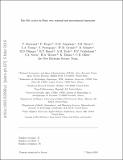The CH4 cycles on Pluto over seasonal and astronomical timescales
Author(s)
Binzel, Richard P; Earle, Alissa M
DownloadAccepted version (5.633Mb)
Publisher with Creative Commons License
Publisher with Creative Commons License
Creative Commons Attribution
Alternative title
The methane cycles on Pluto over seasonal and astronomical timescales
Terms of use
Metadata
Show full item recordAbstract
Pluto's surface is covered in numerous CH4 ice deposits, that vary in texture and brightness, as revealed by the New Horizons spacecraft as it flew by Pluto in July 2015. These observations suggest that CH 4 on Pluto has a complex history, involving reservoirs of different composition, thickness and stability controlled by volatile processes occurring on different timescales. In order to interpret these observations, we use a Pluto volatile transport model able to simulate the cycles of N2 and CH4 ices over millions of years. By assuming fixed solid mixing ratios, we explore how changes in surface albedos, emissivities and thermal inertias impact volatile transport. This work is therefore a direct and natural continuation of the work by Bertrand et al. (2018), which only explored the N 2 cycles. Results show that bright CH 4 deposits can create cold traps for N2 ice outside Sputnik Planitia, leading to a strong coupling between the N2 and CH4 cycles. Depending on the assumed albedo for CH 4 ice, the model predicts CH 4 ice accumulation (1) at the same equatorial latitudes where the Bladed Terrain Deposits are observed, supporting the idea that these CH4 -rich deposits are massive and perennial, or (2) at mid-latitudes (25°− 70°), forming a thick mantle which is consistent with New Horizons observations. In our simulations, both CH4 ice reservoirs are not in an equilibrium state and either one can dominate the other over long timescales, depending on the assumptions made for the CH 4 albedo. This suggests that long-term volatile transport exists between the observed reservoirs. The model also reproduces the formation of N2 deposits at mid-latitudes and in the equatorial depressions surrounding the Bladed Terrain Deposits, as observed by New Horizons. At the poles, only seasonal CH4 and N2 deposits are obtained in Pluto's current orbital configuration. Finally, we show that Pluto's atmosphere always contained, over the last astronomical cycles, enough gaseous CH4 to absorb most of the incoming Lyman-α flux. ©2019 keywords: Pluto; CH4 [methane]; paleoclimate modeling; GCM; glacier; volatile transport
Date issued
2019-09Department
Massachusetts Institute of Technology. Department of Earth, Atmospheric, and Planetary SciencesJournal
Icarus
Publisher
Elsevier BV
Citation
Bertrand, T., et al., "The CH4 cycles on Pluto over seasonal and astronomical timescales." Icarus 329 (September 2019): p. 148-65 doi 10.1016/j.icarus.2019.02.007 ©2019 Author(s)
Version: Author's final manuscript
ISSN
0019-1035